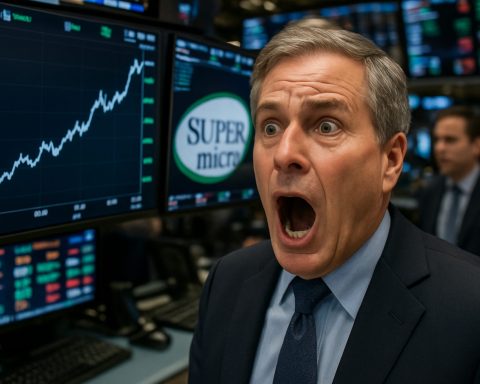- Global trade tensions heighten as the US imposes new tariffs on China, impacting financial markets, especially in the Hong Kong financial hub.
- Chinese EV stocks, including BYD, Nio, Xpeng, and Li Auto, suffer significant declines, with each experiencing over a 10% drop in stock prices.
- The Hang Seng Index and Hang Seng Tech Index see substantial decreases of 9% and over 11% respectively, reflecting widespread investor unease.
- The US tariffs increase by 34%, cumulatively reaching 54% with China responding equivalently, escalating the trade conflict.
- China also retaliates by blacklisting 11 American companies, raising stakes in the ongoing economic tussle.
- Analysts suggest China’s market is better equipped than in past trade disputes, with stronger domestic economic fundamentals and a strategic shift in valuation models.
- Uncertain future for global commerce, as nationalism challenges the interconnected nature of the world economy.
The turbulent dance of global trade has once again taken center stage, sending an electrifying jolt through the heart of Asia’s financial epicenter—Hong Kong. In the early trading hours, leading Chinese electric vehicle (EV) stocks careened downward as US President Donald Trump unveiled a new barrage of tariffs, aimed directly at the juggernaut of China’s economy. This move not only roiled the oceans of global trade but also sent ripples through the financial markets, casting a shadow over the green vision of the EV industry.
In a harrowing display, stalwarts of the EV sector like BYD, Nio, Xpeng, and Li Auto all witnessed their stock prices tumble. BYD plunged 11.15 percent to HK$333.00, while Nio wasn’t far behind, skidding down 11.30 percent to HK$25.50. Both Xpeng and Li Auto faced similar fates, dropping 11.40 percent and 10.82 percent respectively, as investors grappled with this latest act in the ongoing trade saga. The Hang Seng Index felt the pressure too, with a steep 9 percent dive, paralleled by a more than 11 percent drop in the Hang Seng Tech Index, showcasing the widespread trepidation gripping investors.
Trump’s announcement was a two-pronged salvo of tariffs imposing an additional 34 percent on China, building on the 20 percent already levied earlier this year. This tariffs barrage totals an eye-watering 54 percent, a number that both firms and consumers will surely feel. Suddenly, global supply chains seem perilously strung between competing superpowers.
China, not one for silent acceptance, swiftly brandished its retaliatory sword, announcing an equivalent 34 percent tariff on all imports from the US to commence on April 10. Furthermore, it placed 11 American companies on its blacklist of unreliable entities, effectively ousting them from the lucrative Chinese market. As the tit-for-tat escalated, China’s Ministry of Commerce voiced a firm resolve to protect its nation’s interests, urging the US to reconsider its strategies.
Yet beneath these choppy waters, financial analysts from CICC hinted at an undercurrent of adaptation. Echoing lessons from the trade skirmishes of 2018-2019, they suggested that while the tariffs pose a stern challenge, China’s stock market today stands on more favorable grounds. Domestic economic fundamentals have strengthened, and there are whispers of a strategic shift in global valuation models, now more attuned to geopolitical realities than ever before.
Through this tumult, a looming question pervades—the resilience of global commerce against a backdrop of pronounced nationalism. Will this storm forge new paths toward collaboration, or are we witnessing the slow unraveling of the interconnected economic tapestry? Only time can unravel this complex weave of power plays and economic strategy. For now, the streets of Hong Kong echo with the anxiety of investors and the hum of a once-roaring EV future, now temporarily dimmed by the specter of a taxing reality.
Trade Wars: How US-China Tensions Could Reshape the EV Industry
Introduction
The escalating trade tensions between the United States and China have sparked ripples across the global economic landscape. Nowhere is the impact felt more keenly than in the electric vehicle (EV) sector, a beacon of hope in the battle against climate change. With significant tariffs imposed by both nations, this economic confrontation poses essential questions about the future of the global EV market.
Unveiling Additional Facts
1. Impact on Global EV Supply Chain:
– Tariffs increase costs for raw materials and components essential for EV manufacturing. Many of these materials, such as lithium and cobalt, are either imported or processed across complex international supply chains. An increase in costs will likely curb production or lead to increased consumer prices.
2. Potential Shift in Manufacturing Hubs:
– As tariffs bite into profit margins, companies might explore relocating parts of their manufacturing processes to other countries with favorable tariff agreements, such as Southeast Asian nations or India.
3. Innovation Drive Amidst Adversity:
– Companies might accelerate innovations in battery technology to reduce dependency on import-heavy components. This could spur advancements in solid-state batteries and other next-generation technologies.
How-To Steps & Life Hacks
For Investors:
– Diversification: Spread investments across multiple regions to hedge against geopolitical risks.
– Research Back-Up Plans: Look into companies’ contingency strategies and adaptability to regulatory changes.
For Businesses:
– Supply Chain Reevaluation: Consider local sourcing options and building partnerships in neutral countries.
– Cost Management: Invest in technologies and strategies that improve efficiency to absorb tariff costs.
Real-World Use Cases
– Tesla’s Expansions: With ongoing trade tensions, Tesla could further expedite its gigafactory operations outside China, potentially looking toward Europe or further into North America to avoid high tariffs.
Industry Trends & Market Forecasts
– Rise in Regional Trade Agreements: Expect an uptick in regional trade agreements as countries seek to insulate themselves from the volatility of US-China relations.
– EV Industry Growth Despite Tensions: Analysts project continued global growth for EVs, driven by environmental policies and consumer demand, reaching over 50% of new car sales by 2040.
Reviews & Comparisons
Chinese vs. US EV Manufacturers:
– Technology: Chinese companies like Nio and Xpeng are considered leaders in battery technology, while US counterparts such as Tesla dominate autonomy and software.
– Market Adaptability: US companies may better withstand tariffs due to diversified market strategies, whereas Chinese firms could capitalize on their domestic market’s scale.
Actionable Recommendations
– Watch Emerging Markets: With trade tensions affecting China and the US, emerging markets may present new opportunities for EV growth.
– Cutting-Edge Investments: Support firms investing in research and innovation to maintain a competitive edge over disrupted supply lines.
Controversies & Limitations
– Nationalistic Policies: While protecting domestic interests, such policies could curtail international cooperation crucial for tackling global environmental issues.
Conclusion
The ongoing trade tussle between the US and China presents both risks and opportunities for the global EV industry. By proactively addressing these challenges, businesses and investors can steer through this storm to a more sustainable and interconnected future. As the situation evolves, keeping a close eye on geopolitical shifts and technological advancements will be crucial for navigating this complex landscape.
For more insights on global trade and economic strategies, visit the [World Trade Organization](https://www.wto.org) and the [International Monetary Fund](https://www.imf.org).












